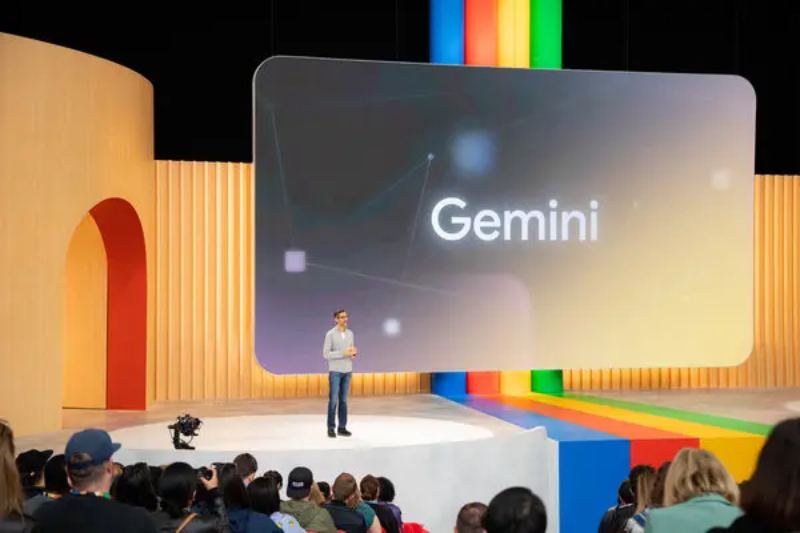
How to Make Use of Google’s Gemini AI in Its Bard Chatbot Immediately
- Technology
- December 7, 2023
Google has finally released Gemini 1.0, its most sophisticated generative-AI model to date, after nearly seven months of rumors and delays. The company is marketing Gemini 1.0 as one of the most powerful software tools ever. According to the company, it can write code, explain memes, solve calculus problems, and—in a real-world example—give feedback on cooking photos so you can judge when your omelet is done. As “a first step toward a truly universal AI model,” Google is even marketing Gemini, which is built from the ground up to interact with text, audio, images, video, and computer code in a variety of contexts. Additionally, everything seems a little lackluster.
Perhaps it’s because the announcement made today feels like every other product launch in Silicon Valley. The three versions of Gemini—Nano, Pro, and Ultra—are designed for progressively more complex tasks and are comparable to the iPhone 15 Plus, Pro, and Pro Max. (At the moment, it’s a branding exercise; Nano and Pro are available now, but Ultra won’t be out until early next year.) At the top end, Gemini can beat OpenAI’s best model, GPT-4, on most metrics, but these are incremental improvements, more akin to a smartphone’s camera bumping up a few megapixels. The most obvious indication yet that generative AI has entered its corporate phase comes with the launch of Gemini.
The launch of Gemini coincides with exactly one month after OpenAI held its inaugural developers’ conference, a day devoted to launching new GPT-based products and showcasing their revenue streams. The conference bore a striking resemblance to both Google’s and Apple’s yearly Worldwide Developers Conferences. Sam Altman, the CEO of OpenAI, was fired after an intense argument at the startup’s San Francisco headquarters, partly due to his hasty commercialization of the company’s technology. This confrontation was sparked by OpenAI’s DevDay. Five days later, he was reinstated with the support of the most influential investors in OpenAI. The largest supporter of OpenAI, Microsoft, now holds a non-voting position on its nonprofit board, joining the second-largest corporation in the world to an organization that was founded to combat corporate greed.
In the corporate generative-AI race, Google, OpenAI, and Microsoft are not the only participants. The CEO of Meta, Mark Zuckerberg, stated clearly during an earnings call earlier this year that “entirely new classes of products” are being created by “foundation models” like Gemini and Llama of Meta, and that better AI leads to more engaging products and more advertising dollars. Amazon Q, an AI-powered assistant designed to assist businesses, was released late last month. The company’s profits were expected to be boosted by a “slew of generative AI releases,” according to a recent earnings report. The chipmaker Nvidia became a trillion-dollar business thanks to the AI boom.
Artificial Intelligence products are becoming more and more similar as Big Tech competes for the same prize. Google CEO Sundar Pichai stated that generative AI will accelerate knowledge and productivity in ways “we haven’t seen before” in a note that accompanied the release of Gemini. However, we have repeatedly heard for years that the newest VR headset, smartphone, or office software will accomplish the same thing. Over the past year, three generative-AI programs have been implemented for Google’s chatbot Bard, which is currently based on the Gemini Pro model. Additionally, OpenAI’s ChatGPT has undergone a few software updates. Bard and ChatGPT improved their ability to describe images; they became less likely to mislead or experience hallucinations, and their writing became clearer and more concise.
Similar to how the iPhone has features that are compatible with the MacBook, these AI models have also begun to offer doors into entire product ecosystems. Microsoft’s cloud services are replete with GPT-powered AI assistants, and Bard can assist you in Gmail, Google Drive, and YouTube. Google’s Pixel 8 Pro smartphone is equipped with Nano, which is specifically made for smartphones. Google claims that using specially designed computer chips to run the entire Gemini suite is the most effective way to train artificial intelligence. Every stage of the AI pipeline involves a Big Tech product, whether for individuals using AI software or for Microsoft, which has adopted a similar strategy with its own models and chips.
The desire for profit, which is more apparent than ever, might allow these tech companies to maintain even greater secrecy. Apple spent years opposing legislation that would have allowed people to disassemble and fix their own devices, partly due to the fear that important trade secrets would be exposed. Along similar lines, it might make sense to keep a close lid on AI, a technology that is already opaque.
“Factuality, child safety, harmful content, cybersecurity, biorisk, representation and inclusivity” are reportedly among the many evaluations that Gemini reportedly received. However, the public is largely unaware of these checks, much like how the detrimental content-moderation and labor practices of previous tech and software behemoths were concealed. (Google did not answer a request for comment regarding Gemini’s safety assessments right away.) It is challenging to verify claims about AI’s capabilities because of its ambiguity, let alone stop models from being created that, for example, use labor that has been exploited or material that has been pirated. It is reasonable to assume, therefore, that the tech companies that best apply Silicon Valley’s long-standing playbook will emerge victorious from the generative-AI race, regardless of whether it brings about true societal transformation or just offers a new profit model.